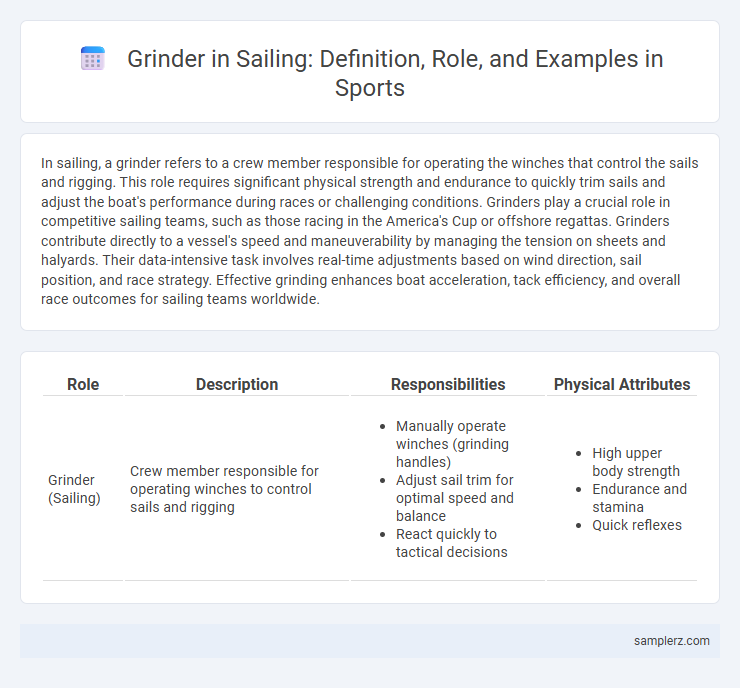In sailing, a grinder refers to a crew member responsible for operating the winches that control the sails and rigging. This role requires significant physical strength and endurance to quickly trim sails and adjust the boat's performance during races or challenging conditions. Grinders play a crucial role in competitive sailing teams, such as those racing in the America's Cup or offshore regattas. Grinders contribute directly to a vessel's speed and maneuverability by managing the tension on sheets and halyards. Their data-intensive task involves real-time adjustments based on wind direction, sail position, and race strategy. Effective grinding enhances boat acceleration, tack efficiency, and overall race outcomes for sailing teams worldwide.
Table of Comparison
| Role | Description | Responsibilities | Physical Attributes |
|---|---|---|---|
| Grinder (Sailing) | Crew member responsible for operating winches to control sails and rigging |
|
|
Defining the Grinder Role in Sailing
A grinder in sailing plays a crucial role by operating the winches that control the sails and rigging, providing the necessary mechanical power to adjust sail trim efficiently. This physically demanding position requires exceptional upper body strength and endurance to maintain precise sail control during intense racing conditions. Grinders directly influence boat speed and maneuverability, making them essential members of competitive sailing teams.
Key Responsibilities of a Sailing Grinder
A sailing grinder operates the winches that control the sails, providing essential power to adjust sail trim and boat speed. Key responsibilities include maintaining consistent physical strength and endurance during races, coordinating with the helmsman and trimmers, and executing precise, quick winch turns to optimize sail tension. Expertise in winch mechanics and teamwork under high-pressure conditions is critical for maximizing boat performance.
Physical Demands: What It Takes to Be a Grinder
Grinders in sailing endure intense physical demands, requiring exceptional upper body strength and cardiovascular endurance to operate the winches continuously during races. The role demands powerful arm and shoulder muscles to maintain high rotational speeds under race conditions, often lasting several hours. Elite grinders train with weightlifting and high-intensity interval training to sustain this level of output, highlighting the specialized conditioning needed for peak performance on competitive sailing teams.
Notable Grinder Positions on Racing Yachts
Notable grinder positions on racing yachts are typically located on the cockpit or near the winch stations, where crew members operate the pedestal winches to control sails and adjust trim efficiently. Elite grinders possess exceptional upper body strength and endurance, enabling them to generate continuous power required for rapid sail maneuvers during high-stakes regattas such as the America's Cup. Prominent teams like Emirates Team New Zealand and Oracle Team USA feature highly skilled grinders who play critical roles in optimizing boat speed and tactical response in competitive sailing events.
Famous Grinders in Competitive Sailing
Famous grinders in competitive sailing, such as Rodney Ardern and Jimmy Spithill, have showcased exceptional strength and endurance, powering critical winches that control sails and optimize boat speed. These elite athletes play a pivotal role during intense races like the America's Cup, where rapid sail adjustments and tactical maneuvers are essential for victory. Their physical fitness and grinding efficiency directly impact the boat's performance, making grinders indispensable team members in high-stakes sailing competitions.
Grinder Equipment and Technology Explained
Grinders in sailing operate advanced winch systems that enable rapid trimming of sails by manually turning handles attached to hydraulic or electric winches, enhancing sail efficiency and boat speed. Modern grinder equipment features ergonomic handles with non-slip grips and durable, lightweight materials such as carbon fiber to reduce fatigue during intense races. Technology integration includes electronic feedback systems that monitor tension and rotation speed, optimizing crew performance and sail adjustment precision.
Grinder Training and Fitness Regimens
Grinder training in sailing focuses on developing upper body strength, cardiovascular endurance, and muscular stamina to sustain continuous hand-cranking of winches during races. Effective fitness regimens include high-intensity interval training (HIIT), resistance exercises targeting the shoulders, arms, and core, and rowing or cycling to improve cardiovascular capacity. Elite sailors often incorporate on-water practice with simulated grinding sessions to replicate race conditions and optimize performance.
Team Dynamics and the Grinder’s Contribution
Grinders play a critical role in sailing by powering the winches that adjust sails, directly impacting boat speed and maneuverability. Their physical endurance and synchronization with the skipper and tactician optimize sail trim during races, enhancing overall team dynamics. Effective grinders not only provide raw strength but also communicate promptly, ensuring split-second adjustments contribute to competitive advantage on the water.
Grinder Strategy in America’s Cup Races
Grinders in America's Cup races play a crucial role by providing consistent and powerful manual rotation to control the sails and winches, directly impacting boat speed and maneuverability. Effective grinder strategy emphasizes endurance and synchronization, ensuring the team maintains peak performance during intense race segments. Optimizing input from grinders can reduce sail trim time, giving America's Cup teams a tactical advantage on the water.
Evolution of the Grinder Role in Modern Sailing
Grinders in modern sailing have evolved from solely providing manual power for sail trimming to integrating advanced physical conditioning and tactical awareness. Their role now encompasses operating hydraulic systems and collaborating closely with the crew to optimize boat speed and maneuverability. This shift reflects the increasing demands of competitive sailing, where physical endurance and strategic input are essential for race success.

example of grinder in sailing Infographic
 samplerz.com
samplerz.com